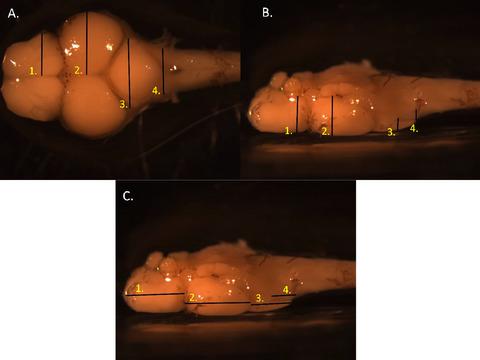当前位置:
X-MOL 学术
›
Ecol. Evol.
›
论文详情
Our official English website, www.x-mol.net, welcomes your feedback! (Note: you will need to create a separate account there.)
Coordinated evolution of brain size, structure, and eye size in Trinidadian killifish
Ecology and Evolution ( IF 2.6 ) Pub Date : 2020-11-22 , DOI: 10.1002/ece3.7051 Kaitlyn J. Howell 1 , Shannon M. Beston 1 , Sara Stearns 1 , Matthew R. Walsh 1
Ecology and Evolution ( IF 2.6 ) Pub Date : 2020-11-22 , DOI: 10.1002/ece3.7051 Kaitlyn J. Howell 1 , Shannon M. Beston 1 , Sara Stearns 1 , Matthew R. Walsh 1
Affiliation

|
Brain size, brain architecture, and eye size vary extensively in vertebrates. However, the extent to which the evolution of these components is intricately connected remains unclear. Trinidadian killifish, Anablepsoides hartii, are found in sites that differ in the presence and absence of large predatory fish. Decreased rates of predation are associated with evolutionary shifts in brain size; males from sites without predators have evolved a relatively larger brain and eye size than males from sites with predators. Here, we evaluated the extent to which the evolution of brain size, brain structure, and eye size covary in male killifish. We utilized wild‐caught and common garden‐reared specimens to determine whether specific components of the brain have evolved in response to differences in predation and to determine if there is covariation between the evolution of brain size, brain structure, and eye size. We observed consistent shifts in brain architecture in second generation common garden reared, but not wild caught preserved fish. Male killifish from sites that lack predators exhibited a significantly larger telencephalon, optic tectum, cerebellum, and dorsal medulla when compared with fish from sites with predators. We also found positive connections between the evolution of brain structure and eye size but not between overall brain size and eye size. These results provide evidence for evolutionary covariation between the components of the brain and eye size. Such results suggest that selection, directly or indirectly, acts upon specific regions of the brain, rather than overall brain size, to enhance visual capabilities.
中文翻译:

特立尼达kill鱼的大脑大小,结构和眼睛大小的协调进化
脊椎动物的大脑大小,大脑结构和眼睛大小差异很大。然而,这些成分的进化错综复杂地联系在一起的程度仍不清楚。特立尼达比目鱼(Anablepsoides hartii)被发现在存在和不存在大型掠食性鱼类的地方有所不同的地点。捕食率的降低与大脑大小的进化变化有关。与没有捕食者的地方相比,没有捕食者的地方的雄性进化出相对更大的大脑和眼睛。在这里,我们评估了雄性kill鱼的大脑大小,大脑结构和眼睛大小演变的程度。我们利用野外捕获的和常见的园地饲养标本来确定大脑的特定组成部分是否已响应捕食差异而进化,并确定了大脑大小,大脑结构和眼睛大小的进化之间是否存在协变。我们在饲养的第二代普通花园中观察到大脑结构的一致变化,但没有发现野生捕获的保存鱼。与没有捕食者的鱼类相比,没有捕食者的地方的雄性致死鱼表现出明显更大的端脑,视神经顶盖,小脑和背髓质。我们还发现大脑结构的进化与眼睛大小之间存在正相关,而整体大脑大小与眼睛大小之间无正相关。这些结果为大脑成分和眼睛大小之间的进化协变提供了证据。这样的结果表明,选择直接或间接地作用于大脑的特定区域而不是大脑的整体大小,以增强视觉功能。我们还发现大脑结构的进化与眼睛大小之间存在正相关,而整体大脑大小与眼睛大小之间无正相关。这些结果为大脑成分和眼睛大小之间的进化协变提供了证据。这样的结果表明,选择直接或间接地作用于大脑的特定区域而不是大脑的整体大小,以增强视觉功能。我们还发现大脑结构的进化与眼睛大小之间存在正相关,而整体大脑大小与眼睛大小之间无正相关。这些结果为大脑成分和眼睛大小之间的进化协变提供了证据。这样的结果表明,选择直接或间接地作用于大脑的特定区域而不是大脑的整体大小,以增强视觉功能。
更新日期:2021-01-08
中文翻译:

特立尼达kill鱼的大脑大小,结构和眼睛大小的协调进化
脊椎动物的大脑大小,大脑结构和眼睛大小差异很大。然而,这些成分的进化错综复杂地联系在一起的程度仍不清楚。特立尼达比目鱼(Anablepsoides hartii)被发现在存在和不存在大型掠食性鱼类的地方有所不同的地点。捕食率的降低与大脑大小的进化变化有关。与没有捕食者的地方相比,没有捕食者的地方的雄性进化出相对更大的大脑和眼睛。在这里,我们评估了雄性kill鱼的大脑大小,大脑结构和眼睛大小演变的程度。我们利用野外捕获的和常见的园地饲养标本来确定大脑的特定组成部分是否已响应捕食差异而进化,并确定了大脑大小,大脑结构和眼睛大小的进化之间是否存在协变。我们在饲养的第二代普通花园中观察到大脑结构的一致变化,但没有发现野生捕获的保存鱼。与没有捕食者的鱼类相比,没有捕食者的地方的雄性致死鱼表现出明显更大的端脑,视神经顶盖,小脑和背髓质。我们还发现大脑结构的进化与眼睛大小之间存在正相关,而整体大脑大小与眼睛大小之间无正相关。这些结果为大脑成分和眼睛大小之间的进化协变提供了证据。这样的结果表明,选择直接或间接地作用于大脑的特定区域而不是大脑的整体大小,以增强视觉功能。我们还发现大脑结构的进化与眼睛大小之间存在正相关,而整体大脑大小与眼睛大小之间无正相关。这些结果为大脑成分和眼睛大小之间的进化协变提供了证据。这样的结果表明,选择直接或间接地作用于大脑的特定区域而不是大脑的整体大小,以增强视觉功能。我们还发现大脑结构的进化与眼睛大小之间存在正相关,而整体大脑大小与眼睛大小之间无正相关。这些结果为大脑成分和眼睛大小之间的进化协变提供了证据。这样的结果表明,选择直接或间接地作用于大脑的特定区域而不是大脑的整体大小,以增强视觉功能。



























 京公网安备 11010802027423号
京公网安备 11010802027423号